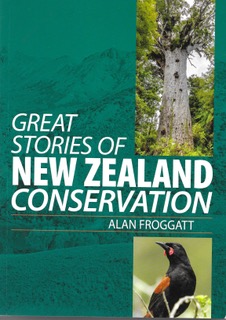Book Review
“Great Stories of New Zealand Conservation” by Alan Froggatt, published by White Cloud Books Upstart Press. Price $39.99. Reviewed by Tony Orman.
Author Alan Froggatt has a long history in conservation endeavours. He has been a keen tramper, hunter. bird watcher, freshwater angler among several outdoor pursuits. He is a long-time member of Forest and Bird.
His book deals with conservation issues and achievements and therefore delves into some areas of debate such as management of the Himalayan tahr in the Southern Alps, eradicating possums, pest fish, Molesworth station, wilding pines, the discovery of the takahe by deerstalker Dr, Geoffrey Orbell, pest control technologies, the hunt for the South island kokako and others. Within these are contentious issues in the public debating arena such as 1080 poison, the role of wild deer in the ecosystem, tahr management, possums and campaigns like Predator Free NZ 2050.
He writes “since 1990, there has been no record anywhere off a kiwi dying from 1080 poison.” I recall interviewing the Karangarua farmer the late Ivor Scott who told me after the blitz of 1080 on South Westland’s Karangarua Valley, the kiwi vanished.
Ravaged Forests
Alan Froggatt maintains “without its (1080) use New Zealand —would have unchecked predators and ravaged silent forests.”
Ecosystems and predator-prey relationships don’t, in the vast majority of cases, happen like that. The kea – the subject of one chapter – was abundant for until about 2000 despite predators having co-existed with the mountain parrot for 200 years. There has to be another reason.
Readers conversant with the high country will no doubt make up their own minds.
Somehow his analysis of the 1970s “Save Manapouri” controversy suggests the Nature Conservation Council which Labour’s cabinet minister Geoffrey Palmer shortsightedly obliterated in his “Quango Hunt” in 1990 was formed following the Save Manapouri issue. In fact the Nature Conservation Council was formed in 1962. It was a government agency set up largely in response to the increasing opposition to a hydro-electricity scheme that was being planned at that stage, for Lake Manapouri. Despite being a government agency, embarrassingly for the National government, the council opposed the plan to raise Lake Manapouri in the public’s Fiordland National Park. The power was essentially for a trans-national corporation’s aluminium smelter at Bluff.
Unfortunately some proof reading errors crop up such as the names of Forest and Bird officer Kevin Hague and DOC scientist Josh Kemp. Disappointingly a number of chapters are very brief, hardly doing the subject justice.
Nevertheless the book is an interesting read.

